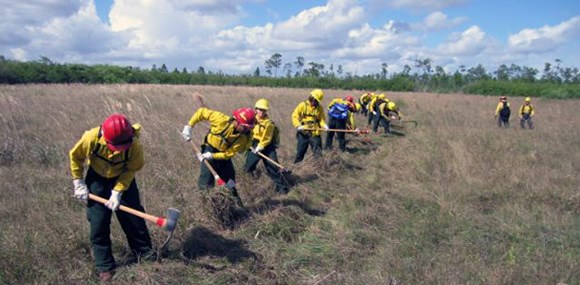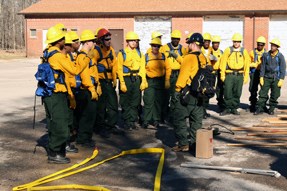Last updated: January 30, 2017
Article
Southeast National Parks Train 165 New Wildland Firefighters
“Thanks to the energy of our trainers at these four parks, we have built significant capacity in our own staff and our cooperators to safely manage planned and unplanned ignitions across the region.”—Samuel Larry, Southeast Regional fire management officer
Between December 2011 and March 2012, the national parks of the Southeast Region trained 165 new wildland firefighters in S-130/190 courses at four separate units, including Mammoth Cave National Park, Kentucky; Kings Mountain National Military Park, South Carolina; Cumberland Island National Seashore, Georgia; and Everglades National Park, Florida.
The courses known as S-130/190, Firefighter Training and Introductory Wildland Fire Behavior, are usually taught with L-180, Human Factors on the Fireline, and make up the basic 40-hour training course required for the entry-level operational qualification in wildland firefighting, Firefighter Type 2.

Mammoth Cave Fuels Specialist Drew Page accounted for the lion's share of the new firefighters trained in the Southeast Region this season. Between November 28 and December 14, 2011, Page taught S-130/190 for 41 members of the Bowling Green Fire Department (BGFD). The goal for providing training to the BGFD was to train firefighters who could assist on incidents and fires in Mammoth Cave NP and eventually work as national resources, available for wildland fire assignments out of the region. The whole BGFD attended, from the chief to the rookies. Page also taught S-130/190 to 13 students at Western Kentucky University at Bowling Green. Finally, Page trained 51 members of the Great Onyx Job Corps, including three staff members.
At Kings Mountain National Military Park in South Carolina, Chief Ranger Chris Revels and Forestry Technician Alex Scronce trained 16 new firefighters. Two of the students were members of the longstanding NPS fire internship program at Clemson University, while two others were Clemson students who will be casual hires or AD firefighters by Kings Mountain on an as-needed basis. In addition, there were four students from South Carolina Department of Natural Resources, seven students from the US Forest Service, and one student from the forestry division at the Army's Fort Jackson.
----
On the Georgia coastline, Cumberland Island Fire Management Officer Ody Anderson helped local cooperators Camden County Fire and Rescue train seven new firefighters. Anderson then crossed the Florida state line to put on S-130/190 at Timucuan Ecological and Historic Preserve, where he trained six firefighters from his own park and eight from Timucuan, as well as one person each from Georgia Forestry Commission and US Fish and Wildlife Service.
Much further south, Everglades National Park Firefighter Erika “Riki” Hoopes coordinated an S-130/190 course for eight National Park Service employees and 10 cooperators. In addition, three other participants from Belize working in the park on an exchange program also graduated from the course.
Southeast Regional Fire Management Officer Samuel Larry stated, “Thanks to the energy of our trainers at these four parks, we have built significant capacity in our own staff and our cooperators to safely manage planned and unplanned ignitions across the region.”
Contact: Samuel Larry, regional fire management officer
Email: samuel_larry@nps.gov Phone: (404) 507-5624
Tags
- cumberland island national seashore
- everglades national park
- kings mountain national military park
- mammoth cave national park
- wildland fire
- cohesive strategy
- fy2012
- response to wildfire
- training
- students
- outreach
- partnerships
- interagency cooperation
- facilities safety
- life safety
- kentucky
- south carolina
- georgia
- florida
- southeast
- ser
- mammoth cave national park
- kings mountain national military park
- cumberland island national seashore
- everglades national park
